9 Best Spots in Ronda: Bridges, Bulls, Flamenco and more!

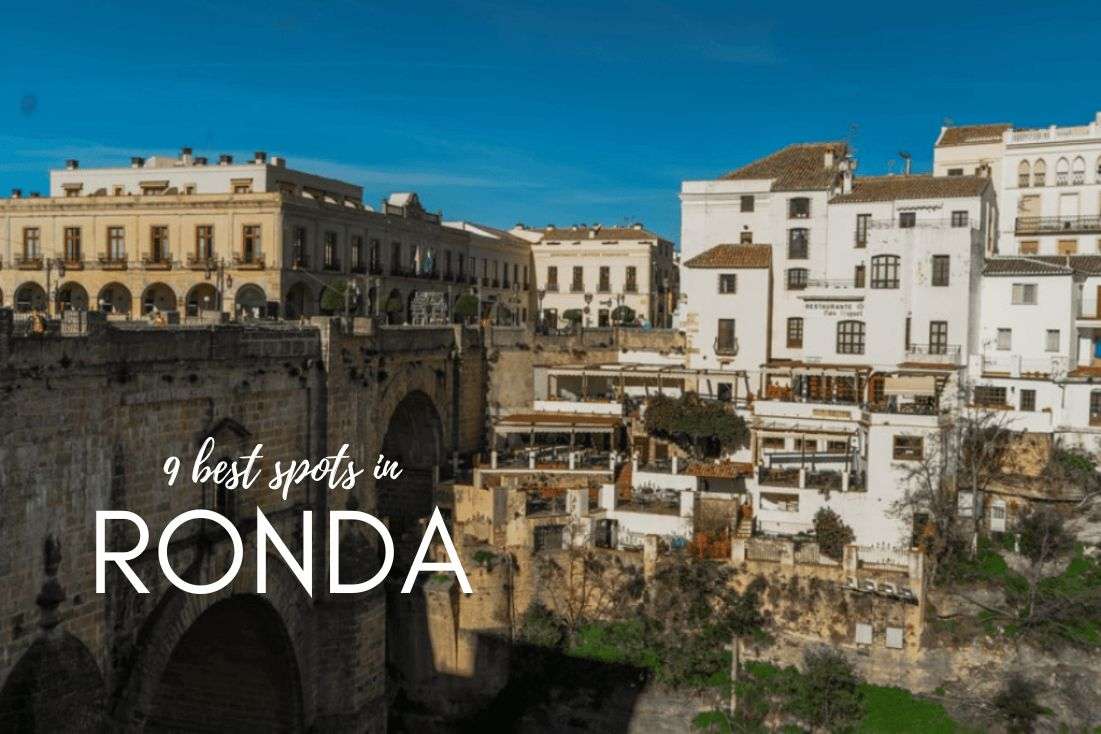
If you are planning your Andalusia itinerary, you probably already know about the big three – Granada, Sevilla, Cordoba. But if you look a little further down the list of top places to visit in the region, you stumble upon Ronda. A smallish town way above the rest – literally.
Ronda sits atop a limestone rock formation, sprawling gorge a 330 feet deep. Five seconds and a quick Google search later you are adding the small town to your itinerary, because you have to see that bridge for yourself! Right off the bat I need to warn you though – the service at restaurants sucks in Ronda!
Getting there is pretty straightforward, though not very fast. From any major destination city in Andalusia, you are looking at a minimum of 1.5 hours in the car driving 2 minute miles. You are, after all, going to be driving through the countryside, so just relax, stare out the window and try not to get car sick.
There are also direct train routes from Cordoba and Granada, and buses from everywhere for those of you who want the trip to be less comfortable but slower!
You might also be interested in reading:
- Andalusia Itinerary: Southern Spain in 10 Days
- Barcelona Itinerary: 5 days in Gaudí’s Metropole (with day trips)
- All You Need to Know about Spanish Tapas (+Restaurant Tips)
- The 10 Best Museums in Spain’s Top Cities
- The 16 Most Beautiful Beaches in Spain
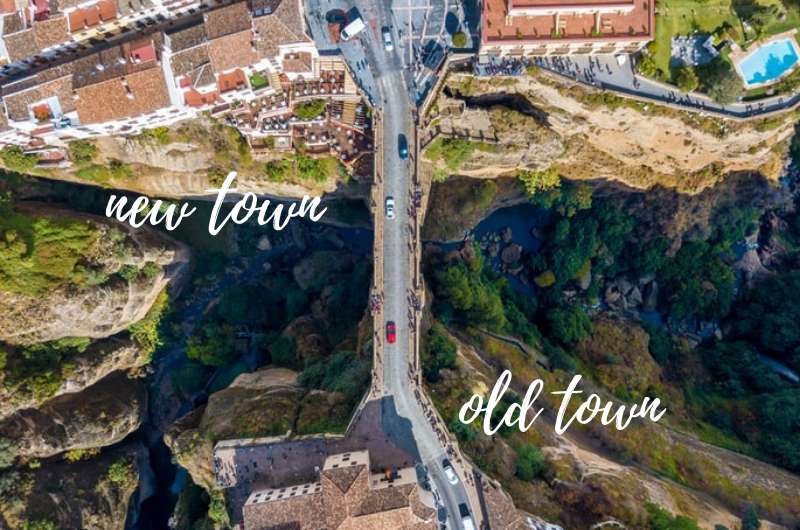
Puente Nuevo in Ronda over the El Tajo (gorge)
How long do you need in Ronda?
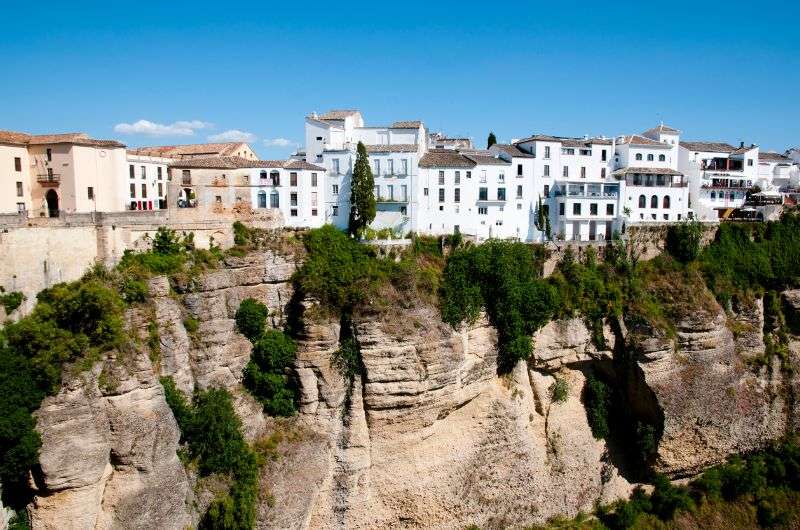
Ronda city
Most tourists come here on a day trip if that answers your question. Ronda isn’t a wild and noisy tourist center even on the best of days, but to experience it with mostly just the locals and take in the gorgeous sunset, stay a night. Unless that sounds boring.
It’s a slow-mo kind of place. That is great for some people, like Ernest Hemingway and Orson Welles, both of whom spent many summers here, fascinated by the bullfighting traditions. George Eliot even named one of her famous characters Daniel Deronda – get it, de Ronda? Meaning “from Ronda”. Seems Ronda is pretty inspiring, right?
Why Ronda was disappointing
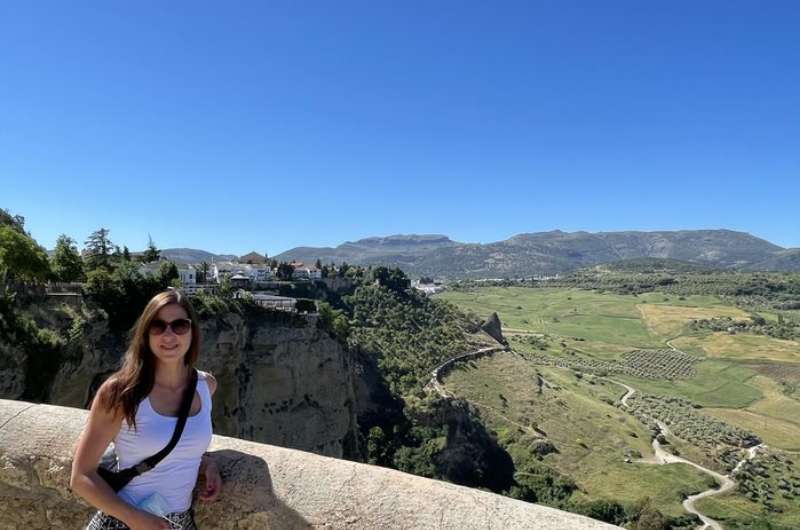
Ronda – the views weren't shabby
It might've been my own fault. I went in with high expectations, perhaps setting myself up for failure. Ronda is nice. The views are also nice. The gorge is awesome, I'll give them that. Even the bull fighting museum and tour was cool. BUT! Where Ronda sucked the most was the terrible service and appalling restaurants. And since bad service can destroy even an otherwise great restaurant, my experience of Ronda was somewhat compromised.
Imagine you just want to get a coffee. Nothing unusual, right? You sit down at one of the restaurants. It was entirely empty I might add. They refused to serve us because we didn't order a meal. I looked around at the empty tables, trying to figure out how a business owner could be so stupid. We then left and after peeking into another couple of bars and restaurants, all of which looked horrendous, we happily accepted a gross cup of coffee at McDonald's. Let that sink in, it is really that bad in terms of service in Ronda.
Orientation
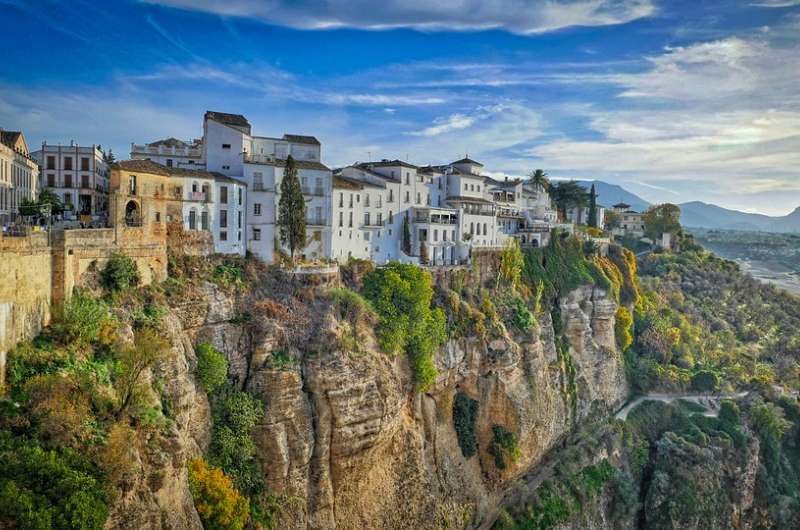
Ronda views
Ronda’s tiny Old Town is on the south side of the el Tajo (gorge). That is where you’ll find the Moorish architecture, the cobblestone streets, the ancient walls and gates of the city… the old stuff that tourists appreciate. The New Town to the north is where the majority of the town lies and where you can see the bullfighting arena, the McDonald’s and the Burger King.
The old part of town is called la Ciudad, simply meaning “the city”.
What to see in Ronda
So what else is there to see beside the bridge? A bull-fighting arena, Arab baths, cobblestone streets, tiled courtyards, and views of the mountains in the distance. Also, wine that comes out of a wall.
1. Puente Nuevo – the New Bridge
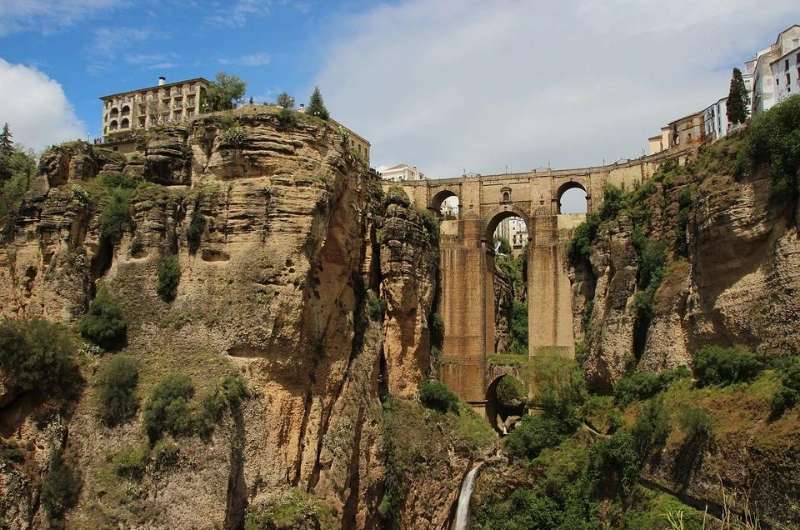
View of New Bridge in Ronda from a viewpoint in the gorge
You may be thinking the bridge doesn’t look very new, and it’s not. Finished in 1793 after 34 years of construction, it’s old. But by Andalusia standards, where Moorish architecture from the 14th and 15th centuries is what most people come here to see, it’s downright new age!
Puente Nuevo replaced another bridge, I’m guessing we can now call that the Old Bridge. In a fantastic feat, the original bridge was built in a mere 8 months. Six years of walking and horsing across later, it collapsed, killing dozens of humans and an unknown number of horses. So not such a fantastic feat. And maybe we should be calling it The Crappy Bridge.
You can stare at the views of the landscape from it, see the Rio Guadalevín flowing below it, but you won’t really be able to see the bridge itself. For that, you’ll need to walk south, away from the city.
Put on some good walking shoes folks, it’s time to hike a little! Since Ronda sits up top, anywhere you go will see you walking either down or back up.
For some of the best views of the New Bridge, first go to the viewpoint within the town called Mirador de María Auxiliadora. It’s all downhill from there! The path into the gorge is apparent from the viewpoint, and you just stay on the trail and keep hitting better and better spots to take that pic of the bridge. You’ll know when you hit the end, the best spot of all. Now you have to make your way back up.
2. More viewpoints to see the bridge from
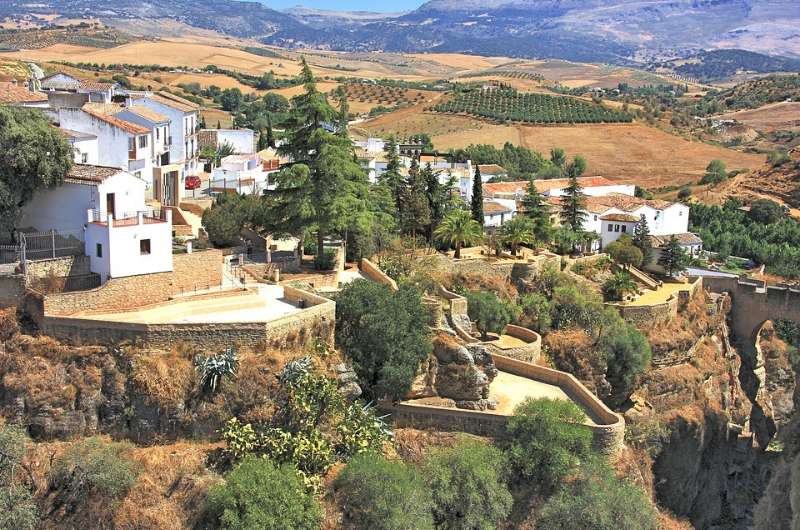
Ronda terraced garden Jardines De Cuenca
You’ve seen it from the top, you’ve seen it from the front, err, south. Does a bridge even have a front? Anyway, to see it from the back/north, there is a viewpoint called Mirador de Adehuela. It’s facing the New Town and is awfully close to the bridge, so you can admire not only it but also the whitewashed houses standing at the very edge of the gorge.
If you look from Mirador de Adehuela to your right across the gorge, you will notice a terraced garden called Jardines De Cuenca. The paved paths of the gardens take you quite a bit down into the gorge, giving you a different perspective on not only the bridge, but just the town in general. It’s impressive!
You might feel that all I’m writing about is how to get the fifth view of one bridge. You’d be correct! Ronda really is tiny and there isn’t much else to do but get views and views of different views, ok? Just read on for more things to do. Or, if you start drinking wine right when you get to Ronda, I bet those views will be funner in no time!
3. The Ronda city gates and the other puentes
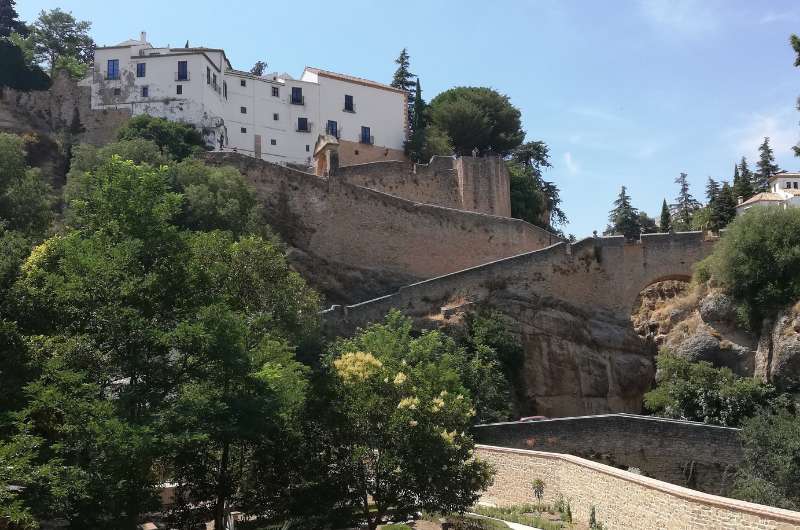
Walking up to Ronda from the Arab Baths
But what’s that over there? Standing on one of the terraces of the Jardines de Cuenca, you look over to the other side away from the Puente Nuevo and see… another puente! I told you Ronda is fun, what could be more exciting than another bridge.
I mean it makes sense, surely they wouldn’t have just one bridge connecting the two sides of the gorge, what if it collapsed or something.
The Puente Viejo is much older than the New Bridge. It was built in the 16th century. There is also a smaller bridge next to it, the Puente Arabe. If you look through the bridge gate, the Arco de Felipe V towards the new town, you will get a great snapshot with the white houses stacked up on each other in the distance. Score! Another view!
(I know I poked a bit of fun at the newer part of town above, but it is still pretty and worth a stroll!)
This is also where you can see the remains of the old walls that protected the city back in the day when they still had walls to protect cities. It is in great shape and has a massive gate that makes you want to stop and think twice about entering the city. Just kidding, you’re a tourist, not a bad guy.
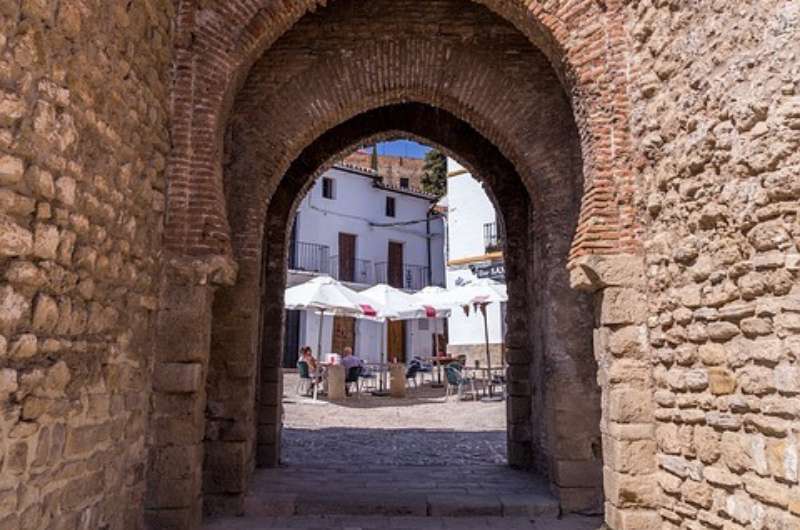
One of the city gates
Visitors (good guys like traders) would cross enter through a gate at the Puente Arabe (it’s no longer there) and head along the stream to the city gates at Puerte de la Cijara. Given that the walls were mostly built during Islamic times, most visitors back then would first stop by the Arab Baths and then a mosque that stood where the chapel stands by the gate today.
The much grander gate further down at Almocabar may look like a main entrance, but it was only used by the limited traffic coming in from the coast, or by local farmers needing to go into that specific part of the city. There used to be a cemetery right by the gates where the square is today, so not exactly where you’d want to welcome your guests. Just the bad guys.
4. Ronda’s Arab Baths, the Baños Árabes
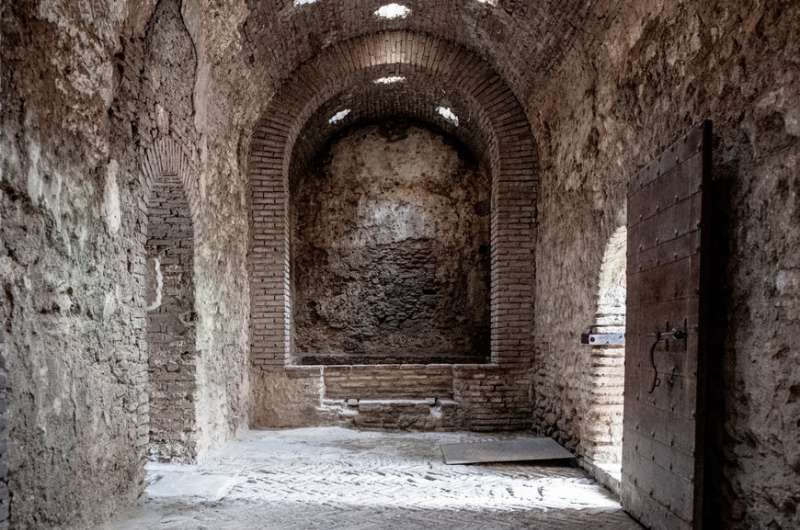
Ronda Arab Baths
The Arab Baths I mentioned above are one of the best preserved baths of this type in all of Andalusia. That is simply because they are so hard to reach, or were, way back when. They were built in the 13th century and used by Muslims and visitors alike to purify themselves before visiting the mosque, and just as a sanitary facility in general. But don’t imagine the process as a quick scrub and you’re done. People would spend hours in here, socializing, relaxing, and going through the hot, warm, and cool rooms over and over.
You can see the roof of the baths from the Puente Arabe (bridge). The roof is lumpy, rounded, with many little skylights, nowadays covered by glass panels. The baths themselves are partially underground, though the first room, formerly the changing room, has lost its ceiling. The other rooms are intact.
A furnace room was built close to where the water entered the baths from the aqueduct in order to heat it up. Unlike the Romans, the Moors didn’t bathe in the water, rather using steam to cleanse themselves. They had an impressive system of underground pipes for the steam to travel through the individual rooms. Not bad engineering.
There are three main rooms: the cool room was for relaxing and cooling down (and chatting for hours with your neighbor about your other neighbor), the warm room provided services such as massages and perfumes (and some more talking with Bob), and the hot room was very steamy, like a sauna. Repeat until you’re all bath’d out!
The warm room shows a great animation about the baths and how they used to be used. Overall, you won’t spend more than 30 minutes here. If you actually could bathe here, you’d work up a new sweat on the way back up to town. A disadvantage to having your town perched up on a mountain, I guess!
- Located right by the Puente Arabe at the end of C. Molino de Alarcón.
- Open Monday to Saturday 10am—6pm, with a break between 2pm—3pm on Mondays and Saturdays; Sundays 10am—3pm.
- Tickets: EUR 4.50 per person.
5. Bullfighting at Plaza de Toros
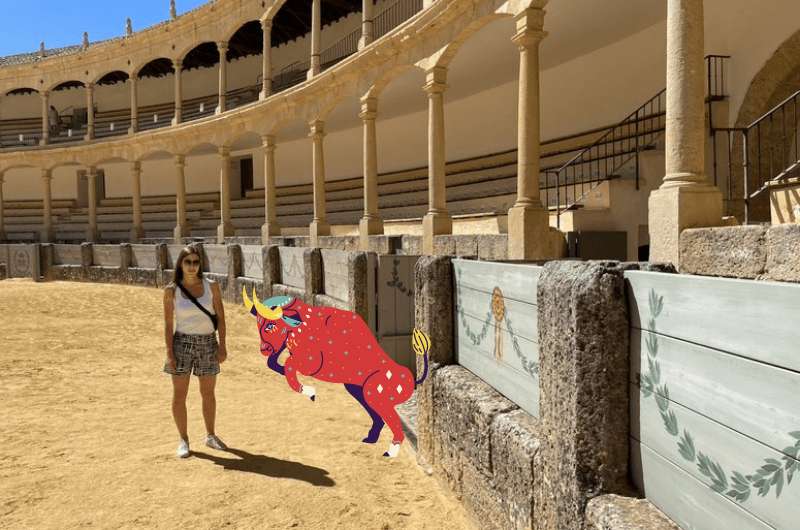
Karin with a real bull at the bullfighting ring! She was so lucky!
From one old tradition to the next, let’s talk about bull fighting. Built by the same architect that designed the New Bridge, José Martín de Aldehuela, the bullfighting arena Plaza de Toros is considered the birthplace of modern bullfighting. The arena is two stories and all the seating is covered by a roof that used to be covered by Arabic tile, making it extra attractive and famous around the world.
Fighting or otherwise handling bulls had been a tradition in Spain since the Middle Ages. Up until the 18th century when the Romero family appeared in Ronda, the bullfighters rode horses in the ring. Probably because they haven’t started drugging the poor animals to make them confused and slow yet. Then, Pedro Romero decided to get in the ring with the bull on foot, and the rest is history. His courage and skill earned him and the trade in general great respect. Plus, when he retired after fighting 5,000 bulls, he had never been so much as injured during a fight. Or so they say.
Fascinated by bullfighting, Ernest Hemingway named one of his characters in his novel ‘The Sun Also Rises’ Pedro Romero.
The next big bullfighting dynasty, the Ordóñez family, elevated the tradition even more. Antoñio Ordóñez, the most famous of the family, gave life to the Goyesca bullfight in 1954. The term comes from the name of painter Francisco de la Goya who often painted bullfights in a way that they looked so glamorous and extra, always remembering to include fancy costumes, beautiful women etc. He even painted portraits of Pedro Romero himself.
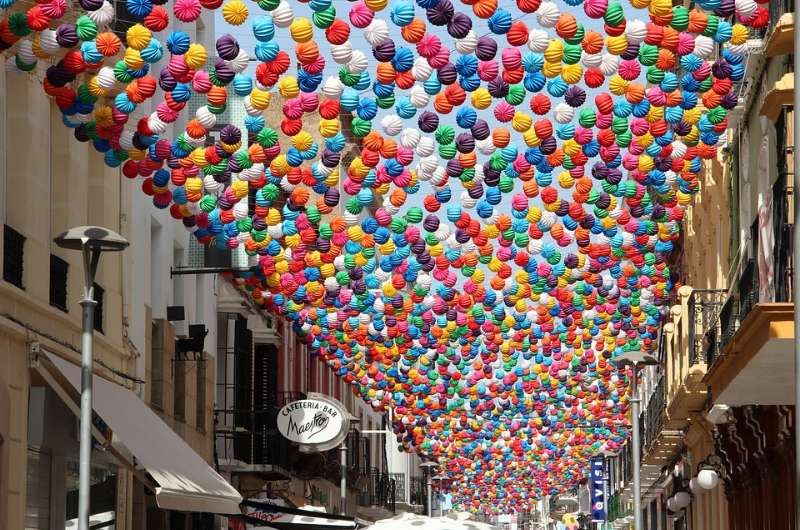
Feria Goyesca de Pedro Romero
Antoñio Ordóñez wanted to pay tribute to Romero and organized a bullfight with all the glimmer and glitz that shines through in Goya’s paintings. It was a spectacle exceeding the bullring, with week-long festivities and a special atmosphere throughout the entire city. Everyone but the bulls loved it.
Nowadays, there is an annual ‘Feria Goyesca de Pedro Romero’ which takes place the first week in September. There is a procession of horse-drawn carriages with everyone, including the matadors, dressed in 18th century costumes.
There is a museum at the arena and you can take a tour of the bullfighting ring to find out more about this lovely pastime. This was actually quite interesting and we can recommend it.
- C. Virgen de la Paz, 15.
- Open daily 10am—6pm in the winter months, until 8pm in the summer.
- Tickets are EUR 6.50 per person or EUR 8 with audio guide.
6. Flamenco
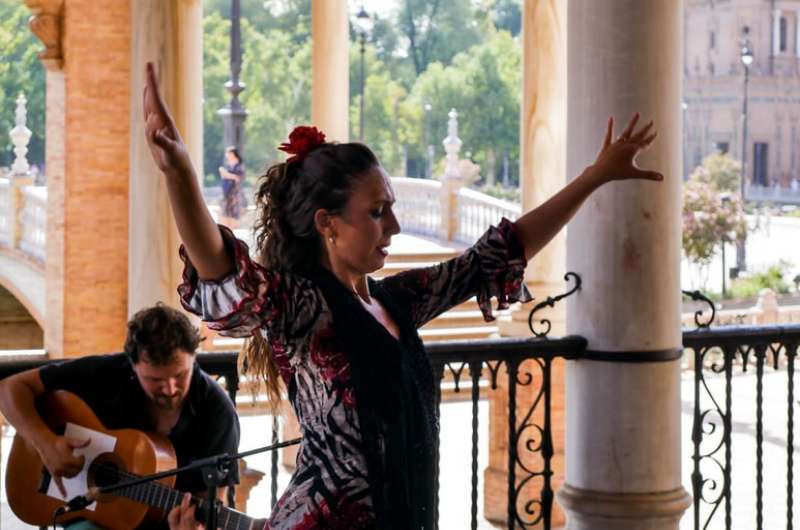
There's not a lot of smiling in flamenco
You’ve bathed, you’ve fought some bulls, now it’s time to stomp your feet, kick up your skirt and clap your hands! Flamenco music originates in Andalusia, and Rondo hosts the oldest and very popular Flamenco festival Cante Grande de Ronda. It takes place every August when Flamenco lovers flood Rondo.
There are several spots where you can get your flamenco on even when it isn’t flamenco festival time. The Lara Museum hosts shows 3 times a week, as does Casino de Ronda. You will see a full music and dancing show. Other times in other places, you might just get a guitar show.
7. Calle Armiñán and Calle Virgen de la Paz
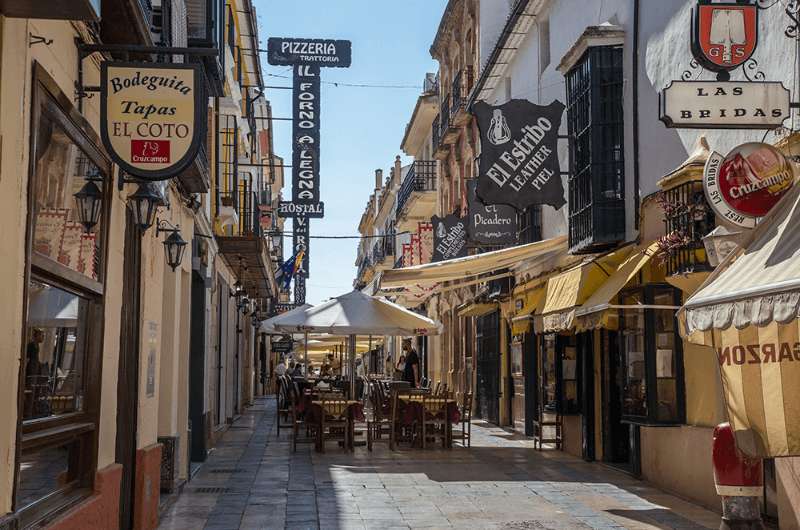
Calle Armiñán. Image source: www.growlermag.com
When you’re done with all the main sights (yes, that was all), you need to take a stroll down Old Town’s main street – Calle Armiñán. You’ll find tons of shopping in little shops, crappy bars, and historical buildings worth your gaze. I mean you're there already, you might as well take a look.
If you cross the New Bridge from Calle Armiñán, the street turns into Calle Virgen de la Paz on the other side, where you can continue your stroll in the newer part of town. It takes you by Paseo de Blas Infante and the bullring, all the way to Alameda del Tajo, a park with tree-lined promenades, and at the edge, balconies over the cliffs that you can get more incredible views from.
8. Buildings
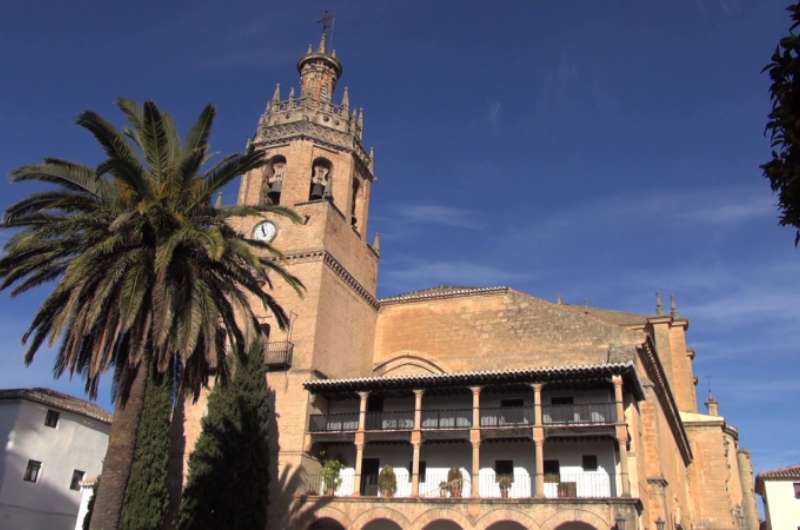
Iglesia de Santa María la Mayor. Image source: www.malaga.es
Speaking of historical buildings, you just need to wander through the Old Town and you will see some interesting structures. Two to look out for specifically are Casa del Gigante, which is a private home built in the 13th or 14th century and is one of very few belonging to Nasrid architecture. This is what a house of a wealthy Muslim family would have looked like in that time.
The Palacio Mondragón has been converted into a museum. You can learn about the history of the region here, as well as admire the two styles it presents: the Mudejar and the Renaissance.
The Iglesia de Santa María la Mayor is a mosque turned into a Catholic church. For EUR 3, you can climb up the winding stairway to a viewing platform for some lovely views. Because I’m sure you haven’t had much of those this whole stay in Ronda!
Tip: The Museo B Casco Historico is an apartment you can rent if you want to feel like a Rondonian from centuries ago – it has a dome in the living room. It’s also steps away from Iglesia de Santa María la Mayor and Casa del Gigante.
9. Sunset
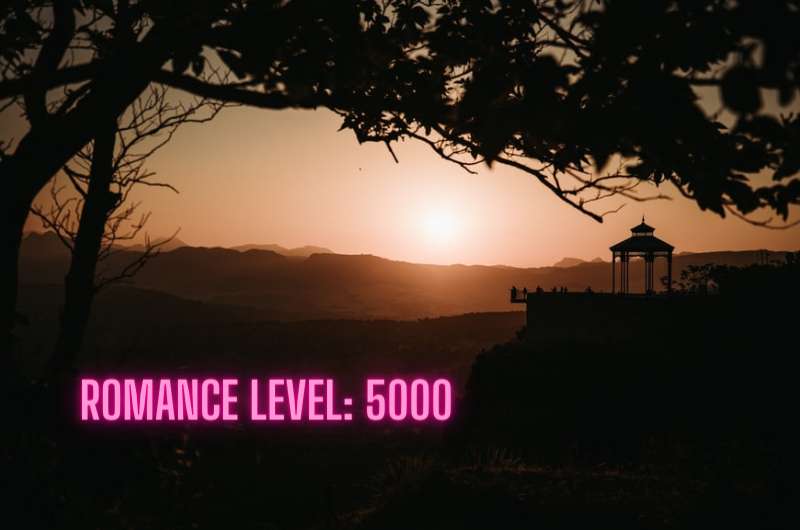
Sunset at the gazebo in Paseo de Blas Infante
There, you did it, you’ve seen Ronda. If you are a sunset lover or you for some reason are stuck in town, the sunset will make up for the shitty restaurant experiences. The sunset might even make your list of top sunsets ever. And then you will want to name a character in your novel something like Sunseta Deronda!
Head to El Balcon del coño or simply Mirador de Ronda on Google Maps. It’s in a park, Paseo de Blas Infante, with an Ernest Hemingway statue and lots of stray cats.
Or head back down to the first viewpoint that you ogled the New Bridge from down in the gorge, and see it again with the light at the perfect angle for the best photos. You know you want to see that view again!
There’s something about watching the sunset perched upon a mountain above every other town around that makes it feel that much more special, like that sunset is somehow more yours. Ronda does sunsets well.
There are also many hotels that will give you a killer sunset view. One of those is Catalonia Ronda, with a rooftop pool overlooking not only views of the natural beauty surrounding Ronda, but you can actually see into the bullring at Plaza de Toros!
Goodbye Ronda
You’ll want to add Ronda to your itinerary on a day when you need a breather between ticking boxes of all the must-see sights of the big cities. If you aren’t in a hurry you can spend the night, relax, have a glass wine or three, hit the sack early for a change. But if you’re stressed for time, don't worry about it, you can see Ronda easily in half a day (plus travel times… which is another half day).
What’s that you say? I didn’t tell you about the wine that comes out of a wall? It’s at the Wine Interpretation Center, where you can take a tour and tasting. Honestly, in my dreamland, this would be standard. One faucet where you can connect your hose and get water to water your garden or wash your car. And another faucet for you to get yourself some wine at any time of day for absolutely no reason at all.
I guess even though it wasn't the best destination, Ronda can still be inspiring. I need to write down this wine faucet idea. Maybe I'll even name it "Ronda" when I apply for the patent.
This post may contain affiliate links. We earn a small commission if you make bookings through my links, at no additional cost to you. This helps us keep this blog free, thank you!


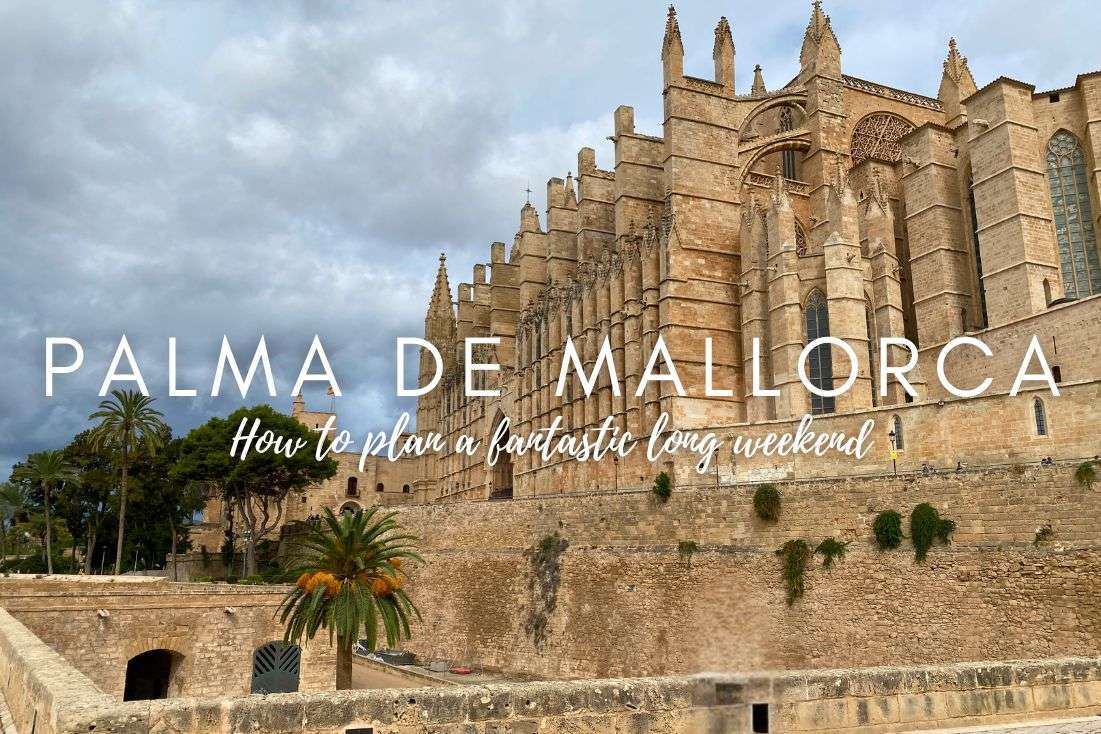
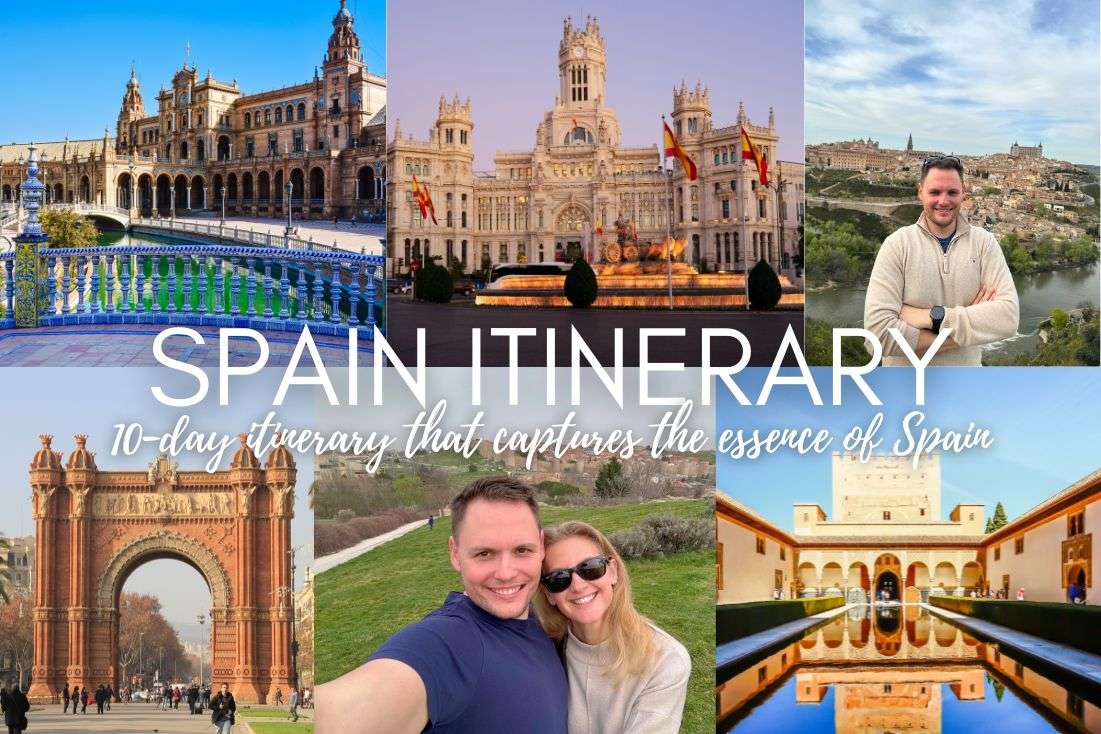
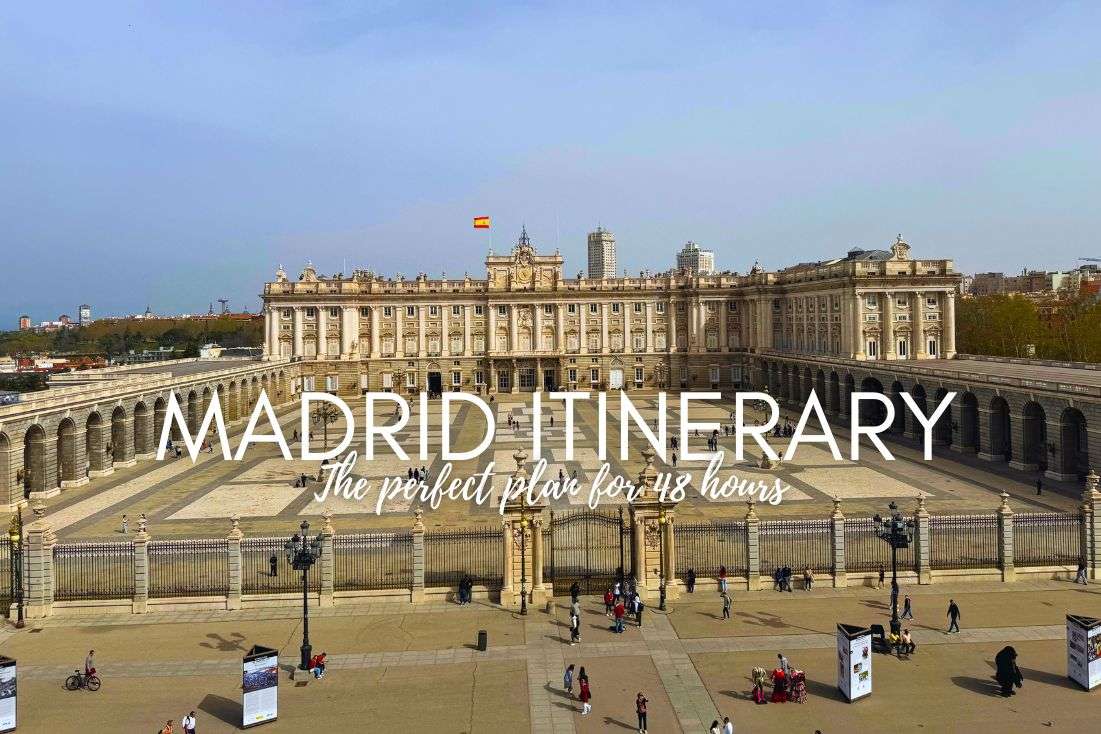





Comments | Thoughts? Give us a shout!